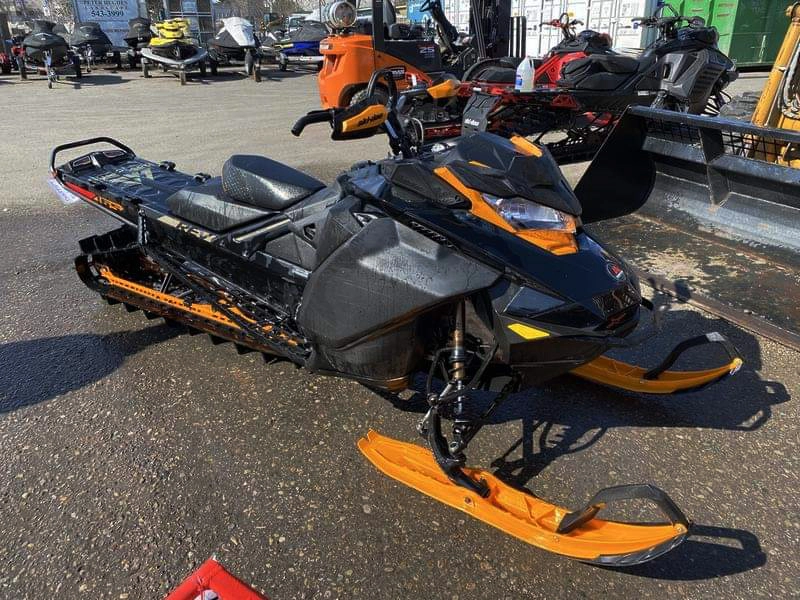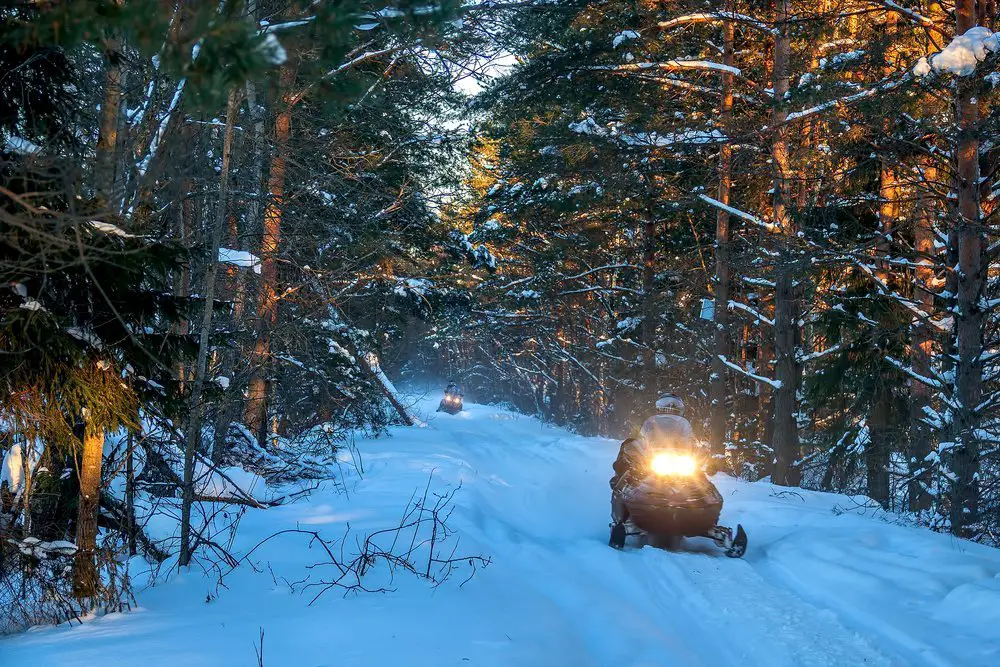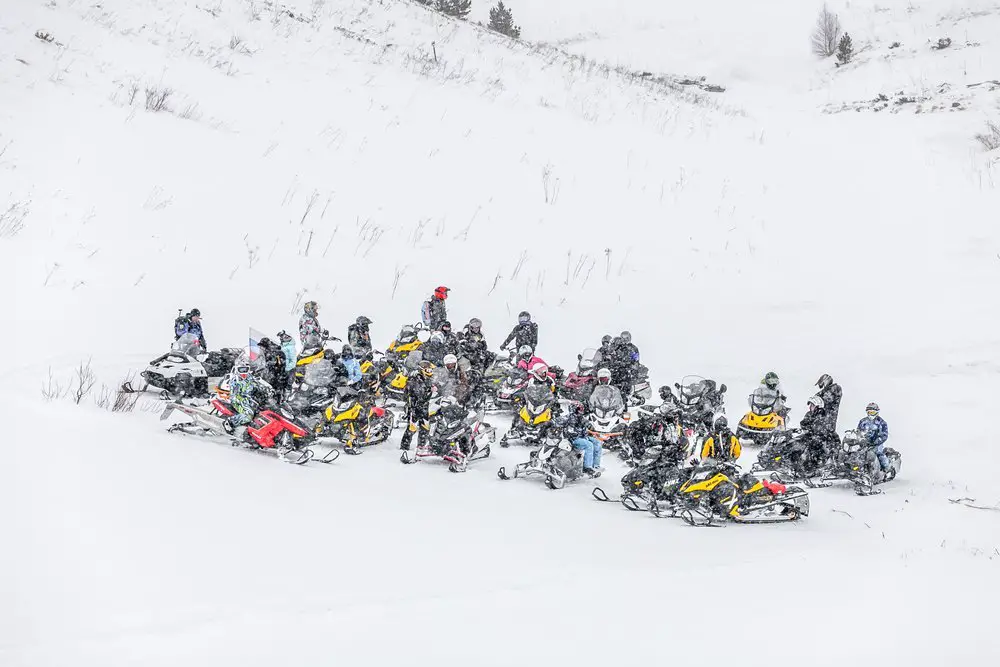A brand-new snowmobile can cost you upwards of $20,000. Naturally, that is a lot of money for anyone to shell out for a hobby. This is why many opt to go the way of purchasing a used snowmobile.
Buying a used snowmobile comes with questions and concerns, the main one being; what is considered high mileage for a snowmobile?
Anything over 8,000 miles (12,900 km) is considered high mileage for a snowmobile. 4,000-8,000 miles is considered medium mileage and anything under 3,000 miles is considered low mileage for a used snowmobile.
| Grade | Miles | Kilometers |
| Low mileage | Less than 3,000 | Less than 4,800 |
| Medium mileage | 3,000 – 8,000 | 4,800 – 12,900 |
| High mileage | More than 8,000 | More than 12,900 |
How much mileage you get out of a snowmobile entirely depends on the maintenance history and how the sled was driven.
When buying a used snowmobile, these are important things to consider. If the seller isn’t interested in sharing the maintenance history, it’s a good sign to avoid buying from t
Table of Contents
Not all mileage is the same

When we talk about the mileage of a snowmobile, generally anything over 8,000 miles is considered high mileage. However, this is just a generalization, there are five major factors to consider when looking at the mileage of a used snowmobile:
- Maintenance history
- Type of snowmobile
- Age of the sled
- How it was ridden
- 2-stroke vs 4-stroke
Let’s get into a little more detail about each of the five things you should be looking for when buying a used snowmobile, aside from mileage.
1. Maintenance history
Perhaps the most important thing you should be looking at when looking to purchase a used sled is its maintenance history.
A used snowmobile could only have about 2,500 miles on it, but if it was neglected and the owner didn’t carry out regular and seasonal maintenance, you could be in for a lot of trouble.
In addition, It’s always a good idea to perform an inspection yourself, even if the seller provides you a maintenance record. As nice as it would be to trust everyone’s word, sometimes sellers list things they’ve replaced or fixed, that haven’t actually been done.
If the seller of the used snowmobile you are looking at says they don’t have a record of maintenance performed on the sled, you should walk away. This is a key indicator that the sled you’re looking at is likely going to need a lot of work done.
2. Type of snowmobile
When looking at purchasing a used sled, it’s important to take note of the type of snowmobile you are buying.
Some machines are ridden harder than others. For example; a trail sled with 2,500 miles on it would generally be in better condition than a mountain sled with 2,500 miles on it.
This is because mountain snowmobiles are typically ridden harder, on rougher terrain and steeper elevations, which can lead to more potential issues than a trail snowmobile being ridden down a nice flat trail on a smooth terrain.
Keep in mind, not all mountain snowmobiles are ridden on mountains. Some people just enjoy the longer tracks and powder skis of a mountain sled and use it for strictly trail riding.
These are questions you need to ask before making the purchase.
3. Age of the sled
Unlike cars or other outdoor toys, snowmobiles can go bad from just age and sitting. There are so many intricate parts that can go dry from just sitting around in the off-season over the years:
- Bearings
- Belts
- Tracks
- Seals
All of these things can become defective and cause damage with age if the sled is not properly maintained or has been sitting for a while.
It’s something to keep in mind when purchasing older models, as they typically come with extra repair costs. Especially if they had been sitting for long periods of time.
I would rather buy a used snowmobile that has 8,000 miles on it, knowing it’s been ridden recently and often, as opposed to a lower mileage snowmobile that has been sitting for long periods of time.
4. How it was ridden
This sort of ties back into the type of snowmobile section.
How a snowmobile has been ridden throughout its life means just as much if not more than the mileage it comes with. There is good mileage, and there is bad mileage.
Bad mileage is what we typically see on mountain sleds that tear through deep powder and rough terrain, this can wreak all kinds of havoc on a snowmobile over time. Good mileage is when a snowmobile is used for casual riding, down trails and around your home.
There are far fewer things that can stress your engine out and lead to issues down the road when you’re traveling along a smooth and flat surface as opposed to a steep mountain.
5. 2-stroke vs 4-stroke
Not all snowmobile engines are equal, so when considering how many miles the sled you’re looking at has, you need to also consider whether it has a 2 stroke or 4-stroke engine.
Naturally, a 4-stroke engine provides you with more long-term reliability compared to a 2-stroke engine.
If you look at a 4-stroke with 8,000 miles on it, it will typically run better and be in better shape than a 2-stroke engine with the same mileage.
Something else to consider here however, is that buying a used snowmobile comes with the understanding that you may need to perform a top-end refresh or a complete rebuild in the near future.
It is much cheaper to rebuild the top end or even the entire engine of a 2-stroke than a 4-stroke.
How Many Miles Does A Snowmobile Last?
A snowmobile typically lasts between 5,000 and 20,000 miles. 2-stroke snowmobile engines will need to be rebuilt sooner than a 4-stroke snowmobile engine. Proper maintenance and storage are huge factors that play a role in determining how many miles your snowmobile lasts.
It’s not totally out of the norm for people to get well over 20,000 miles out of their sleds, these are people who treat their machines with the upmost care.
Something to consider is that 4-stroke snowmobiles last longer than 2-strokes because they are able to make more power with fewer revolutions per minute of the engine and are equipped with a better lubrication system.
Two stroke engines
Your average 2 stroke snowmobile engine will last 2,500-5,000 miles (4,000 – 8,000 kilometers) before you are going to need to have the top end refreshed and between 5,000-10,000 miles (8,000 – 16,000 kilometers) before the engine needs to be completely rebuilt.
Four stroke engines
With proper maintnance a 4 stroke snowmobile engine will last between 10,000-20,000 miles (16,000-32,000 kilometers) before the sled’s engine will need work.
How to increase the lifespan of your snowmobile
In order to increase the lifespan of your snowmobile, you need to perform regular maintenance and repairs, both before and after the season is over.
You also need to properly store your sled away during the off-season. Let’s get into a little more detail about the things you can do to ensure your snowmobile lasts a long time.
Pre-season maintenance
There are a number of things you should be checking on your sled before the season officially starts.
Nothing is worse than having the first sledding trip of the year planned out only to find out your snowmobile simply won’t start on the day you’re set to leave, and you can’t figure out why. This is easily avoidable by following a simple pre-season checklist each year.
Some of these will only apply to those of you with 2-strokes and some will only apply for people with 4-strokes.
Snowmobile pre-season checklist
1. Inspect your belt
It’s really important that you check the life and tension of your snowmobile belt before the season gets underway.
Look for any signs of wear, tears or missing cogs that would lead you to believe it’s time to change the belt. If everything looks good, give it a clean and move on to the next step.
Check the tension of your belt, if the belt is either too tight or lose, make the necessary adjustments.
2. Inspect and service your clutches
Now that we are done with the belt inspection, you can move on to your primary and secondary clutch.
Clean your clutches of metal debris and belt residue and then perform an inspection looking for any signs of wear and damage.
On the primary clutch, ensure each roller doesn’t have any flat spots and that they are able to rotate freely. Be sure to check the fly weights to see if the bushings or pins have worn out and replace if necessary. Inspect your primary spring to ensure it’s not broken or fatigued.
Also, check your secondary clutch to ensure the roller bushings on the spider aren’t seized or damaged.
If you are unsure how to perform these tasks, check out this great video. Alternatively, take your sled into a shop to have it looked at.
3. Inspect your track
Inspecting your track is a key piece of sled maintenance, both pre- and post-season.
Give your track a good spin around and check to see if any of your paddles/lugs are ripping off, if the track has any tears that need addressing and if your clips are bent, loose or missing.
Next, you are going to want to check your track tension.
Track tension is how tight the track is on your sled, and is pretty important. If the track is too loose it can ratchet around the drive sprockets, but if it’s too tight then you can run into wear along the length of your rear suspension.
This can lead to your sliders and bearings in the idler wheels wearing prematurely. You can check the tension of your track using a tension gauge, refer to your machines manual for proper track tension settings.
4. Check chaincase tension
Check your snowmobiles chain tension by slightly moving your secondary back and forth. If there is a little bit of movement, you need to properly tension your chain.
5. Inspect and replace spark plugs
Spark plugs are a vital part that you need to get your sled going.
Do a complete inspection of both the insulators and electrodes for any signs of wear and carbon buildup.
Take a look at the gap and make corrections if it looks off, your sleds manual should tell you how big the gap on your spark plug should be.
Spark plugs are relatively cheap, usually running anywhere between $5-$30, so it’s always a good idea to just replace them each season.
6. Check cylinder compression
While you have the spark plugs out, you should check your snowmobile’s compression.
Ideally, you want your sled to have equal compression in all cylinders and to read between 120-140 PSI. 110 PSI is fine, but anything less is a sign that you may be looking at some repairs.
7. Inspect your carbides
Before the first ride of the season, you should be taking a look at your carbides.
Inspect your carbides for any signs of damage or wear. Worn down carbides can cause your snowmobile to lose performance, so if you notice they look a bit rough, you should replace them.
8. Check your fluids (and for leaks)
At the beginning of every season, you should be checking and topping up or refreshing all of your fluids.
If you run a 2-stroke be sure to top up with fresh oil and if you have a 4-stroke make sure you change the oil.
After you are done topping up all of your fluids, do a full inspection for any signs of leakage.
Post-season maintenance
At the end of the snowmobiling season, you really need to summerize your snowmobile for storage.
Sure, it’s easier to just store it away, but you run the risk of a handful of problems at the beginning of your next season.
Post-season snowmobile maintenance is rather easy and well worth the time and effort.
Snowmobile post-season checklist
1. Stabilize your fuel
When prepping your snowmobile for storage, you should make sure it has a full tank of fuel.
Storing a sled with an empty tank can result in your gas gauge float and seals to dry out and become damaged.
When you do this, it’s important to mix in fuel stabilizer to prevent the gas from breaking down and becoming bad gas that can damage and corrode your Carburetor.
2. Fog your engine
If you plan on running your sled’s engine at least once a month during the off-season, you do not need to follow this step.
This process should be done outdoors.
Fogging your snowmobile is the process of spraying fogging oil int your snowmobile’s intake until the sled stalls.
This ensures the internals of your engine (rod pins, cylinder walls, crankshaft etc.) are oil-coated which protects them from moisture which can lead to corrosion.
3. Grease it up
To prevent moisture that causes corrosion to build up while in storage, make sure you grease your drivetrain and suspension system.
I use WD-40, but your manual should let you know what kind to use. Make sure you do not get any on your belts or in the clutch area.
4. Remove battery
Nothing good comes from leaving the battery in your sled during storage.
You never want your battery to completely lose its charge, as this risks the battery no longer being able to hold a charge. If you have a tender, you can use that to keep your battery nice and charged. If not, you can trickle charge it.
While the battery is removed, take a look at the posts for any signs of corrosion.
5. Wash and cover the sled
Now that all that is done, you’ll want to do a complete hose down of your sled. Get all the grime and dirt that has built up throughout the winter.
Once you have your sled clean as a whistle, cover it up to keep off dirt, snow, rain etc.
6. Keep sleed off the ground
If possible, when storing your snowmobile, you’ll want to keep it up and off of the ground to prevent your runners and carbides from becoming rusted and damaged.
The best way to do this is by using a snowmobile stand.
Final thoughts
Not all snowmobile mileage is the same. 4 stroke snowmobiles will last double the mileage of a 2 stroke snowmobile, but costs more to maintain.
How a snowmobile is ridden is a big factor when considering mileage, hard mileage like mountain riding for example will always wear on a sled more than easy mileage you rack up on a trail.
Proper maintenance of your snowmobile can drastically increase the longevity and mileage you get out of it. When buying a used snowmobile, always ask for the maintenance records.


